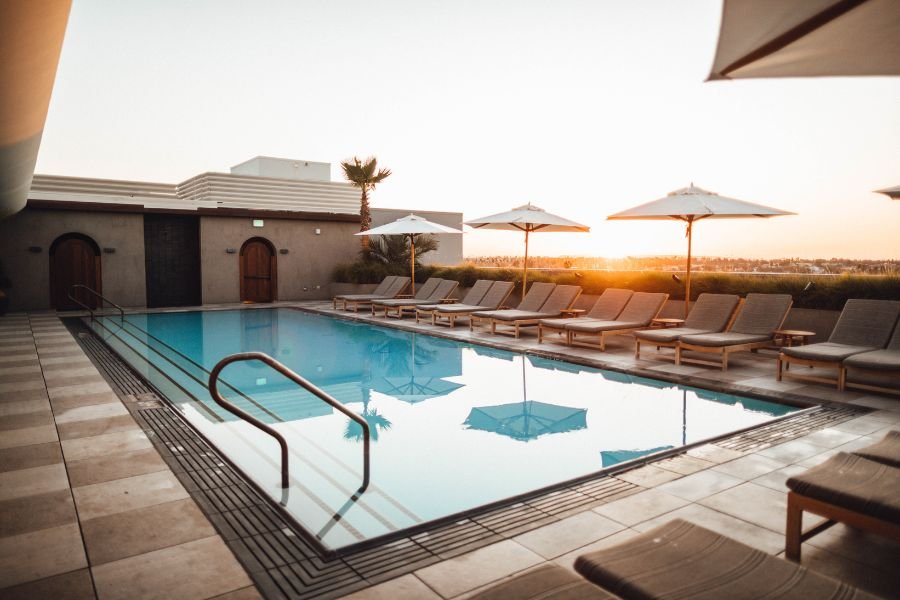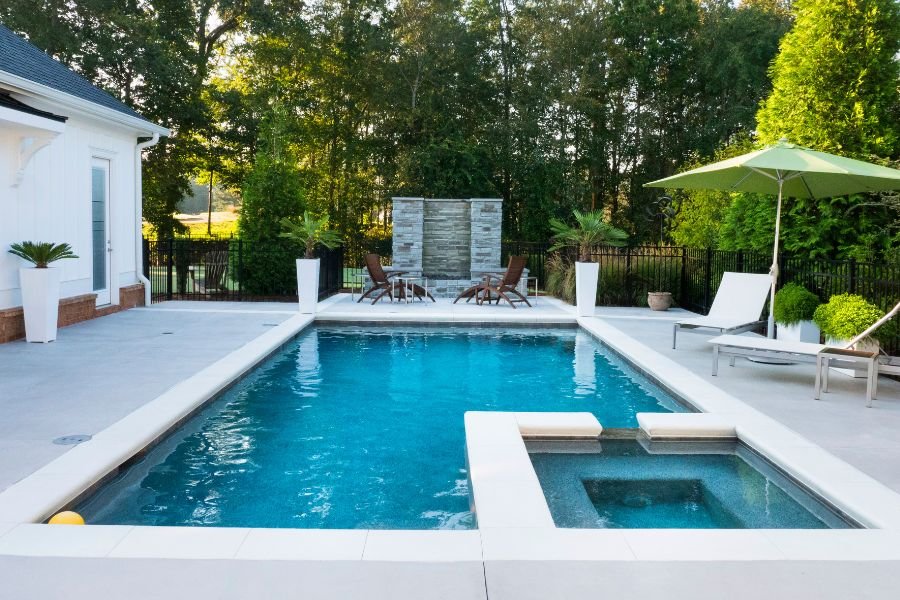There’s a moment that happens in most of our lives—usually somewhere between the third mortgage payment and the first time your teenager asks why everyone goes to other people’s houses to hang out—when you realize your backyard is telling a story you didn’t mean to write.
It’s not terrible, exactly. Just… adequate. The grass grows. The fence stands. The concrete patio does its job of existing without asking for much attention. And that’s the problem, isn’t it? It doesn’t ask for anything. Including a second glance.
I’ve stood in hundreds of backyards over the years, listening to successful professionals explain what they want their outdoor space to become. Engineers, executives, physicians, entrepreneurs—people who’ve worked hard, earned well, and want something to show for it that doesn’t require a quarterly earnings report. They’re tired of being the family that accepts invitations but never extends them. Tired of summer Saturdays where the kids disappear to someone else’s pool while their own yard sits silent.
And almost always, when the conversation turns to materials and construction methods, there’s a pause. A moment of calculation. Because the default assumption—concrete, gunite, the way pools have “always” been built—comes with an unspoken acceptance of complexity, maintenance, and the kind of timeline that makes you wonder if you’ll still want a pool by the time it’s finished.
Which is exactly why the conversation about fiberglass matters more than most people realize.
When Faster Doesn't Mean Cheaper
Here’s what nobody tells you about concrete pool construction: the timeline isn’t just long because the work is complex. It’s long because complexity multiplies at every stage.
Your contractor excavates. Then they frame. Then they pour. Then they wait for curing. Then they plaster. Then they deal with the inevitable imperfections that arise when you’re essentially building a custom vessel from scratch in someone’s backyard where the soil shifts and the weather doesn’t cooperate and Murphy’s Law applies with particular enthusiasm.
Fiberglass pools install in weeks, not months. Sometimes as little as two to three weeks from excavation to the first cannonball.
This isn’t about cutting corners. It’s about eliminating the corners that shouldn’t exist in the first place. The shell arrives as a complete, factory-manufactured unit—engineered, tested, and finished before a single shovel touches your property. Your installer excavates, sets the shell, connects the plumbing, backfills, and you’re done.
No curing time. No plaster delays. No discovering three months in that the contractor scheduled your tile work for “sometime in the fall, depending.”
For families in premium neighborhoods across Central Florida, time isn’t just money—it’s summer. It’s the season your kids will remember. The evenings you won’t get back. The gatherings that happen now or never at all because everyone’s schedule only gets busier.
The Math Nobody Wants to Talk About

Let’s talk about the lifetime cost of pool ownership, because this is where the initial sticker shock of a quality fiberglass installation starts making a different kind of sense.
Concrete pools require acid washing. Tile replacement. Replastering every decade to fifteen years. Each of these isn’t a minor service call—it’s a project that rivals the cost of a decent used car and requires draining your pool and not using it for weeks while contractors do work that, let’s be honest, you’re funding because the material itself demands it.
The smooth, non-porous gelcoat surface of a quality fiberglass shell keeps its finish for decades. No resurfacing. No replastering. No hidden maintenance costs that make you question whether you bought a backyard amenity or a second mortgage.
Industry data suggests the maintenance time alone drops by up to forty percent compared to concrete pools. Less scrubbing. Fewer chemicals. More time in the water instead of working on it.
That matters when you’re already juggling a career, a family, and a social life that shouldn’t require a degree in pool chemistry to maintain.
The Temperature Thing
There’s a specific kind of disappointment that happens on those beautiful Florida mornings in May—when the weather is perfect, the water is calling, but the concrete pool deck is hot enough to qualify as a hostile surface.
Fiberglass stays cooler. Not theoretically cooler. Actually, measurably, walk-on-it-barefoot cooler.
The gelcoat surface reflects heat rather than absorbing it the way concrete does. Which means your deck stays comfortable even in mid-summer. Which means your kids actually use the pool instead of avoiding it because the approach requires shoes and strategic planning.
It’s one of those details that sounds minor until you live with it. Then it becomes the difference between a pool that sees daily use and one that sits idle because accessing it involves too much friction.
The Algae Conversation

Every concrete pool owner eventually develops a relationship with algae. It starts as a casual acquaintance—a little green tint in the corners, nothing serious. But concrete’s porous texture provides countless microscopic footholds where algae can establish residence and refuse to leave without chemical warfare.
Fiberglass pools don’t eliminate algae. Nothing does. But the smooth, non-porous surface makes it exponentially harder for algae to gain a foothold in the first place. Your pool stays cleaner with less effort and fewer chemicals.
Which matters if you have young children. Or sensitive skin. Or simply object to the idea that maintaining crystal-clear water requires a weekly chemistry experiment and enough chlorine to supply a small municipal water treatment plant.
The Engineering Advantage
Central Florida’s sandy soils and high water table create a specific engineering challenge: movement. Soil shifts. Water tables rise and fall. Concrete pools—rigid, inflexible, built in place—respond to this movement by cracking.
Not might crack. Will crack. It’s not a question of if, but when and how severe.
Fiberglass shells are engineered to flex slightly. They’re designed for precisely the kind of soil conditions that Central Florida provides. The structural warranty that comes with a quality fiberglass pool isn’t marketing optimism—it’s engineering confidence.
For homeowners in areas like Lake Nona, Windermere, and Dr. Phillips where property values justify the investment in quality, this matters. A pool shouldn’t be a liability that requires constant structural repair. It should be an asset that enhances your property without creating maintenance anxiety.
The Design Evolution

There’s a persistent myth that fiberglass pools mean limited options. That you’re choosing from a catalog of generic shapes while concrete offers infinite customization.
This was true twenty years ago. It’s not true now.
Modern fiberglass manufacturers offer an extensive range of designs—from classic rectangular pools to contemporary geometric shapes, from built-in tanning ledges to integrated spas. Many models come with molded steps, benches, and seating areas that would require custom construction and significant additional cost in a concrete pool.
The reality is that most homeowners don’t need infinite customization. They need a pool that fits their yard, matches their aesthetic, and includes the features their family will actually use. Fiberglass delivers that without requiring them to become amateur pool designers in the process.
The Salt Water Advantage
Salt water chlorination systems have become increasingly popular for good reason—they’re gentler on skin and eyes, require less chemical management, and provide a more pleasant swimming experience overall.
But salt water and concrete have a complicated relationship. The salt is corrosive over time, particularly to the metal fixtures and certain types of tile and coping that concrete pools typically use.
Fiberglass pools are specifically engineered for salt water systems. The gelcoat surface is inert—it doesn’t corrode, doesn’t react, doesn’t develop the kind of surface degradation that salt can cause in concrete installations.
If you’re considering a salt water system—and many homeowners in the luxury market are—fiberglass removes a layer of long-term maintenance concern that concrete simply can’t address as effectively.
The Resale Reality
Let’s talk about what happens when you eventually sell your home. Because pools have a reputation for being a neutral proposition at best for resale value—something that some buyers want and others see as a maintenance burden they’d rather avoid.
But here’s what experienced real estate professionals in premium neighborhoods know: buyers in the $500,000-plus market aren’t looking for properties without pools. They’re looking for properties where the pool won’t become their problem.
A well-maintained fiberglass pool with minimal ongoing maintenance requirements and decades of remaining lifespan is an amenity. A concrete pool that’s due for replastering or showing cracks is a negotiation point.
Market data from the Florida real estate market suggests that homes with modern, low-maintenance outdoor features see faster sale times and higher offer rates in desirable neighborhoods. Buyers want the lifestyle without the liability.
The Sustainability Consideration

There’s a growing awareness among homeowners—particularly those in the professional class who’ve reached a certain level of financial security—that consumption choices carry weight beyond immediate cost and convenience.
Fiberglass pools use fewer chemicals over their lifetime. They require less water replacement. The manufacturing process, while not zero-impact, is more controlled and efficient than the on-site construction process required for concrete pools.
This isn’t about virtue signaling. It’s about alignment. The same people who invest in energy-efficient appliances and consider the long-term environmental cost of their choices don’t necessarily want a backyard amenity that requires constant chemical management and periodic complete resurfacing that generates waste and disruption.
The Warranty That Actually Means Something
Most fiberglass manufacturers back their shells with lifetime structural warranties. Not ten years. Not fifteen. Lifetime.
This isn’t a marketing gimmick. It’s a statement about material confidence. Manufacturers know their product will last because the engineering and materials science support it. The gelcoat surface is stable. The structural integrity is proven. The warranty is legitimate because the risk is minimal.
Compare that to concrete pool warranties that typically cover workmanship for a year and materials for maybe five. The difference tells you something important about which construction method the industry itself trusts for long-term performance.
The Decision You're Actually Making
Here’s what I’ve learned after years of conversations in backyards across Central Florida: choosing a pool material isn’t really about construction methods or surface finishes. It’s about deciding what role you want this investment to play in your life.
Do you want a project that requires ongoing management, periodic major renovations, and the kind of relationship where you’re always aware of its demands?
Or do you want an amenity that becomes part of your daily life so seamlessly that you stop thinking about it as a maintenance item and start thinking about it as simply… home?
Fiberglass pools have moved beyond being the “alternative” option. In many ways, for many families, they’ve become the primary choice for people who’ve done the math, considered the timeline, and decided that their backyard should enhance their life rather than complicate it.
The shift isn’t happening because of aggressive marketing or temporary trends. It’s happening because the engineering has improved, the designs have evolved, and enough homeowners have lived with the reality of both materials to make informed comparisons.
If you’re considering a pool—whether it’s your first or a replacement for an aging concrete installation that’s become more burden than pleasure—the fiberglass conversation is worth having. Not because it’s perfect for everyone, but because for many families in the position to invest in quality, it solves problems that shouldn’t exist in the first place.
Your backyard should tell a story of arrival, not aspiration. Of having made it to a place where your home reflects your success without announcing it. Where summer happens on your terms, in your space, with the people who matter most.
That’s not a pool material decision. That’s a life design decision.
And increasingly, for families who understand the difference, fiberglass is how that decision gets built.
Ready to explore what a premium fiberglass pool could mean for your property? Discover how thoughtful design and engineering excellence create outdoor spaces that elevate daily life without demanding constant attention.
